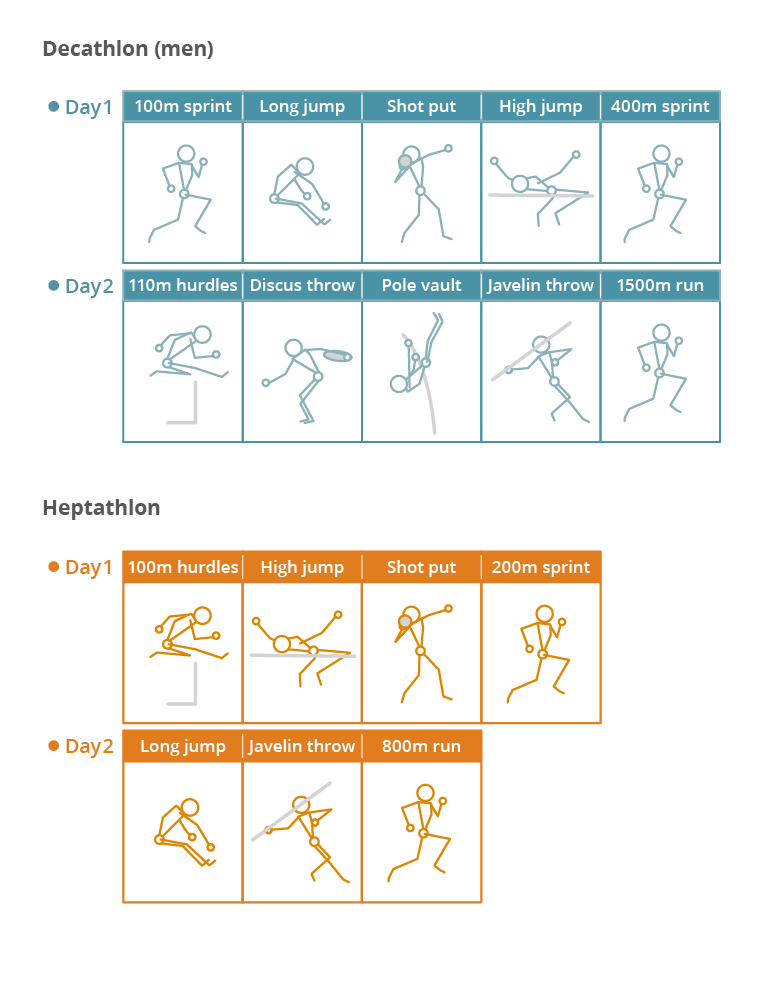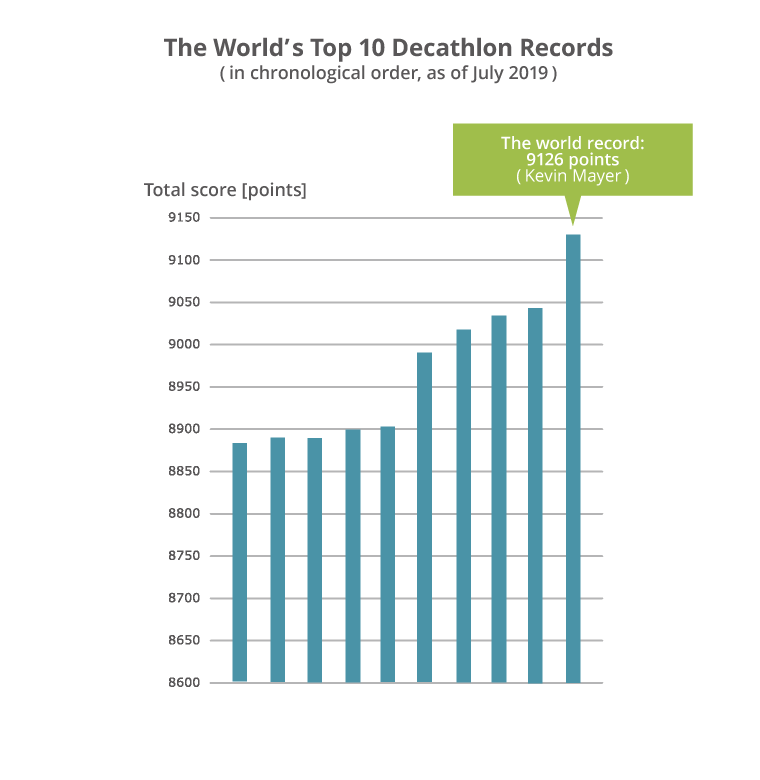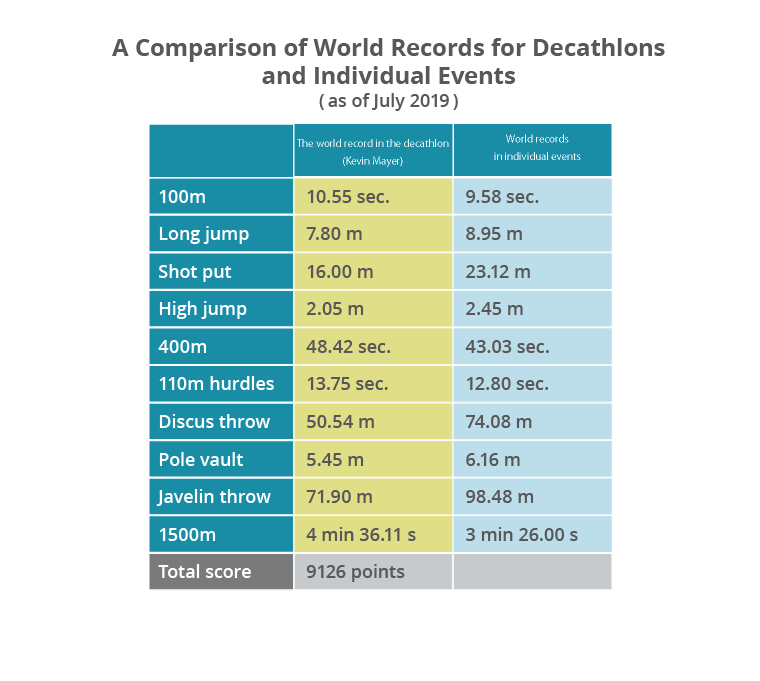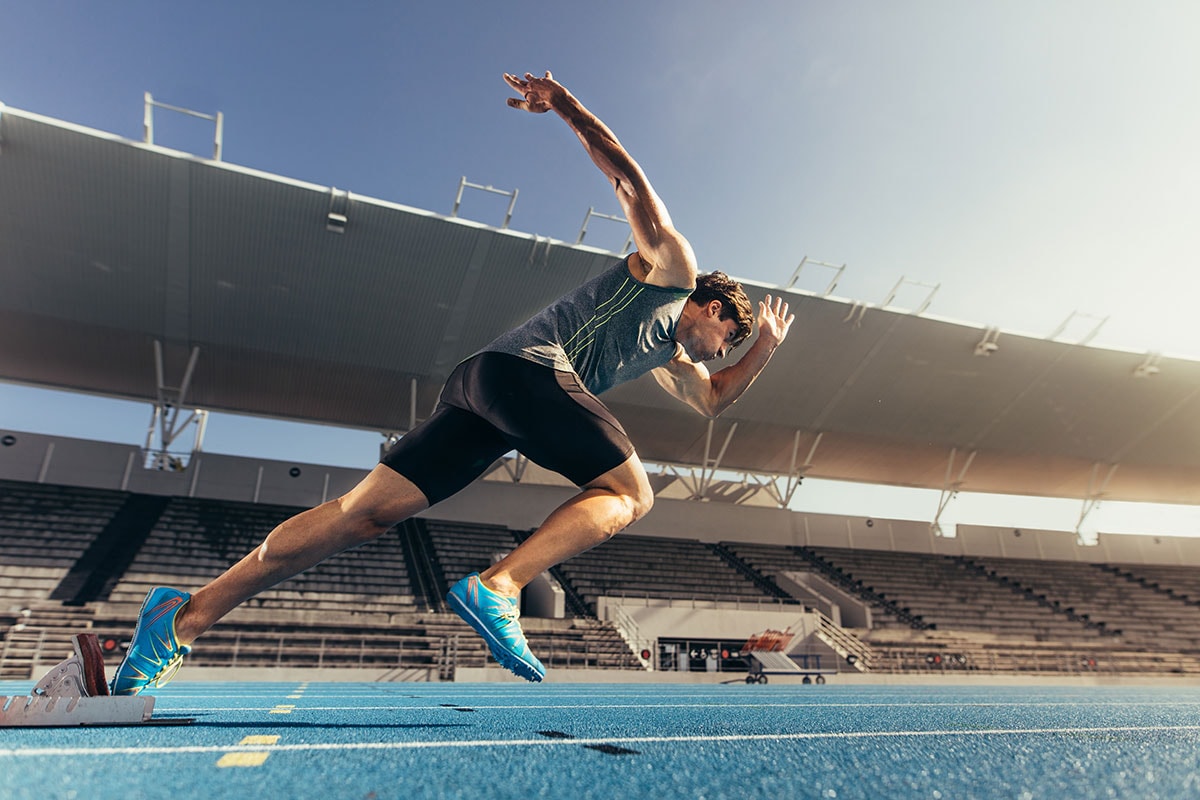World Athletics@TDK
[No.6 The decathlon and heptathlon] What is the decathlon and the heptathlon?

Key Takeaways
1. Decathlon and heptathlon are ultimate all-around events: These multi-discipline competitions span two days and combine running, jumping, and throwing events, testing both physical versatility and mental stamina.
2. Scoring based on complex formulas: Athletes earn points in each event via non-linear equations—small differences in performance can significantly impact total score.
3. World records reflect different strengths: Kevin Mayer holds the decathlon world record due to strength in throwing events, while Jackie Joyner-Kersee’s heptathlon record has remained unbroken since 1988.
4. Stadiums enhance the spectator experience: Track and field arenas offer a unique opportunity to view multiple events simultaneously, with layouts adapted for wind and event type.
5. Real-time biometrics drive athletic improvement: Devices like Silmee™ W22 provide continuous monitoring of vitals such as pulse and movement—crucial for optimizing training and recovery.
Athletes compete in a combination of running, jumping, and throwing events for two days
The decathlon (men) and heptathlon (women) are sporting events fought with a combination of running, jumping, and throwing events. The winners are crowned with the titles of the King of Athletes and the Queen of Athletes, respectively.
These sports have their roots in the pentathlon held in the ancient Greek Olympics, which consisted of the long jump, discus throw, stadion run, javelin throw and wrestling. The word stadion in Greek means a straight alley of about 200m, and is the root of the word “stadium” in English. The suffix -athlon, as in decathlon and heptathlon, comes from the Greek word for “competition,” and some English words like athlete and athletics are also related to the word.
In the decathlon and heptathlon, the following events are competed in over two consecutive days. The sports require athletes to perform running, jumping, and throwing events one after another, as well as managing their time for warming up and practicing before the competition, and then cooling down and taking breaks between events, for which excellent physical competence and perseverance are vital prerequisites, as is mental toughness. For this reason, they are known as the hardest of all track and field sports. Of course, regular training is necessary for all of the events.

Their records (time and distance) are converted into points by designated conversion formulas, with the total score determining the ranking order.
The formulas are very complex, take for example the 100m sprint. It is calculated as score = 4347 x (18-T)1.81 [points], where T is the recorded time (second). This can be calculated using a scientific calculator, today apps for PCs and smartphones are available which calculate scores simply by entering the recorded times or distances. Here are the world’s top 10 decathlon records.

The current world record in the decathlon is 9126 points, achieved by Kevin Mayer in 2018. The previous world record was held by Ashton Eaton from IAAF World Athletics Championships Beijing 2015, where the new world record of 9045 points was achieved for the first time in 14 years. Mayer easily broke this record with his amazing points score, exceeding it by nearly 100 points.
While Mayer’s records in the short and middle-distance runs fell short of those of Eaton’s, his good results in the throwing events (shot put, discus and javelin throws), which he is strong in, considerably contributed to his overall score, allowing him to establish a new world record.
Take a look at the comparisons between his results (times and distances) from the championship and world records in each event. Although Mayer is good in the throwing events, the results were not even close to the world records of individual events. As he is still a young athlete, born in 1992, Mayer draws the world’s attention for his potential to further progress in the throwing events, and improve on his world record in the future.

The world record in the heptathlon remains unbroken for over 30 years
Here are the women’s top 10 heptathlon records. In this sport the current world record is held by Jackie Joyner-Kersee, with 7291 points, which she achieved in 1988. The second best score is 7032 points by Carolina Klüft in 2007, lagging behind the world’s top by a staggering 259 points, which creates intrigue as to who is going to break this outstanding world record.

A stadium offers a unique experience of spectating at track and field events at one time
The decathlon and heptathlon both take place over two consecutive days in the same stadium. A stadium offers the unique experience of watching the track and field events simultaneously among other enthused spectators. Here is a simple illustration of an athletics stadium. Official stadiums where international and other important competitions take place are equipped with several areas for jumping and throwing events, allowing the competition areas to change according to the direction of the wind.
The longest distance throwing event is the javelin, which uses the entire length of the turfed field for throwing. The world record for a javelin throw is 98.48m held by Jan Železný (1996). You may think that it is just a question of time before we see the 100m mark broken, but in fact it was already achieved in 1984, when the world’s first over a 100 meters record was achieved (104.8m). However, it was felt that the turfed area would be too short if the record continued to grow over 100 meters, and so the rules were changed to shift the center of gravity of the javelin toward its front so that the flying distance would be shortened by about 10%. Today, the official world records for men and women are the ones achieved after 1986 and 1999 respectively.

The last event of the decathlon and heptathlon is the middle distance run (men’s 1500m and women’s 800m), which is extremely hard for athletes physically as well as mentally, because the title of being the king or queen of athletes will be snatched away by others if they fail to beat competitors in the total score, even if they cross the finish line before everyone else. It is exciting to see in this race how athletes play out their strategies against rivals and squeeze out their remaining strength in their final spurt.
Conclusion
The decathlon and heptathlon are more than just sporting events—they are the pinnacle of human endurance, skill, and strategic athleticism. As the physical demands increase, so too does the role of technology. Through advanced sensors and real-time data collection, companies like TDK empower athletes with tools to optimize every aspect of performance and recovery. Whether it’s breaking a world record or fine-tuning daily training, the synergy between sport and science defines the future of elite competition.
FAQ
What are the decathlon and heptathlon?
These are multi-event track and field competitions held over two days—decathlon for men (10 events), heptathlon for women (7 events). They cover sprints, distance runs, jumps, and throws.
How is scoring done in these events?
Each performance (time or distance) is converted into points using predefined formulas. Total points determine the final ranking.
Why is the heptathlon world record so significant?
Jackie Joyner-Kersee's 7291-point record from 1988 remains unbeaten, a rare longevity in athletics, highlighting both her performance and the event's difficulty.
What role does sensor technology play in athletics?
Sensors track biometric and environmental data—like heart rate, temperature, and UV exposure—helping athletes and coaches fine-tune performance and recovery strategies.
TDK is a comprehensive electronic components manufacturer leading the world in magnetic technology






